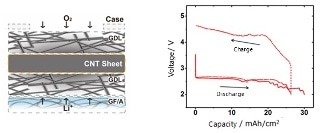May 18 2017
Lithium-air batteries with extremely high electric storage capacity have been developed by a NIMS Research Team headed by Yoshimi Kubo and Akihiro Nomura, Team Leader and Researcher, respectively, Lithium Air Battery Specially Promoted Research Team, C4GR-GREEN.
The electric storage capacity of these batteries are 15 times more than the capacity of standard lithium-ion batteries using carbon nanotubes (CNT) as an air electrode material.
 Conceptual diagram of a CNT sheet air electrode (left) and charge-discharge characteristics of the lithium-air battery with ultra-high capacity (right). Credit: NIMS
Conceptual diagram of a CNT sheet air electrode (left) and charge-discharge characteristics of the lithium-air battery with ultra-high capacity (right). Credit: NIMS
Demand for rechargeable batteries is expected to rapidly increase as electric vehicle power sources and joint sources of household electricity with solar cells. The existing lithium-ion batteries are available with benefits of being compact, having long life and producing high voltages, but they also have an issue in that their energy densities, which represent electric storage capacities, have nearly reached a limit. Lithium-air batteries have immense potential to overcome this issue. The lithium-air battery is considered to be the “ultimate rechargeable battery” comprising of the highest energy density in theory. The battery may have drastically large capacity and reduce production cost. However, standard battery research generally concentrates on fundamental studies of battery reactions using small amounts of materials, and thus is not adequately designed to illustrate greater battery capacities using cells of actual shape and size.
Recently, the Researchers used realistic cell forms to obtain extremely high electric storage capacity of 30 mAh/cm2. This value represents almost 15 times higher capacity compared to the capacity of standard lithium-ion batteries (about 2 mAh/cm2). They were able to achieve this by using CNTs as an air electrode material, thus improving the electrode’s microstructure. The Researchers feel that the large capacity of the battery can be attributed to CNT's flexible structure and large surface area. It is doubtful that the currently available knowledge can explain the capacity increase observed in the study, and these findings could encourage discussion about lithium-air battery reaction mechanisms.
With these findings, the Researchers plan to produce genuinely high-capacity lithium-air batteries at the practical level by analyzing techniques in order to increase energy density in cell layers, known as stack, and also remove impurities present in the air.
JST’s ALCA-SPRING program supported this study, which was conducted in conjunction with the MEXT-commissioned projects titled “Development of Environmental Technology using Nanotechnology” (until FY2015) and "Integrated Materials Development Project" (from FY2016). A FY2015 research grant from Iketani Science and Technology Foundation partially supported this study.